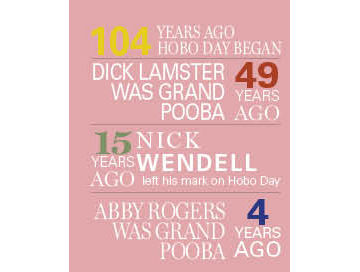Grand poobas continue the homecoming tradition
October 19, 2016
Dick Lamster vividly remembers the Hobo Day parades during his time at State.
The displays of color and school spirit in the 1960s were characterized by a sea of floats, music and enthusiastic observers.
Lamster, 1967 Grand Pooba, also remembers the old cars students would fix up for the parade.
“They were grossly unsafe, but boy were they fun,” Lamster said.
He recalls instances where the “refurbished” cars barely made it through the parade.
These “bummobiles” were just one of the many highlights he had during his three years on the Hobo Day Committee. His time on the committee and Hobo Day celebration gave him “good memories,” “lifelong friends” and “confidence to do the next thing.”
Lamster is not alone in his passion for the biggest one-day event in the Dakotas and for the committee that painstakingly plans the event.
Since the inaugural Hobo Day in 1912, students have dressed as hobos, participated in events and celebrated the tradition as a unified student body.
“Without fail since 1912, students at South Dakota State University came together to celebrate Hobo Day,” said Nick Wendell, director of the Center for Student Engagement.
The former Hobo Day Committee member and 2001 Grand Pooba sees the week-long celebration as a “unifying force” at South Dakota State University.
Wendell has transitioned from being a member of the committee to overseeing them as a co-adviser with Abby Rogers.
“It (Hobo Day) is a student-driven and student-focused celebration,” he said. “It is a monumental task to plan a 104-year-old celebration and each year a group of very committed students come together and do all of the heavy lifting.”
Since the first Hobo Day, the celebration and the committee that organizes the events have experienced a few problems in their past, which led to the committee being under UPC, said 2016 Grand Pooba Corey Chicoine.
The Hobo Day Committee was absorbed into the University Program Council in 1991 following destructive parties during Hobo Day in 1990 and stayed under the organization until 2011.
Wendell was grand pooba while the committee was under UPC, and believes the Hobo Day Committee “benefited greatly” from the oversight of UPC.
But 20 years was enough time for the organizations to be connected.
“It was time for them to step out on their own and restore some of those identity pieces that the Hobo Day Committee really needed,” Wendell said.
He viewed the 100th Hobo Celebration as the year to “hit the reset button.”
Abby Rogers was the grand pooba during the 100th Hobo Day in 2012 and the first year out from under UPC.
Rogers remembers a few hiccups that occurred following the split from UPC, but she expected that after having the support of another organization.
“The committee really felt like they owned Hobo Day Committee again,” Rogers said. “It was theirs instead of UPC planning Hobo Day, and then Hobo Day just supplemented that this was really our own event again.”
Her goal as grand pooba during that transitional year was to stop looking at the celebration year by year, but rather a continuous celebration. The committee that year wanted to bring back traditions that were implemented during previous Hobo Day events.
Rogers admires the culture the Hobo Day Committee has created the last four years on their own.
“It’s traditions-based and they’ve really done a lot of work learning the traditions and talking with alumni and really appreciating where Hobo Day came and what it’s gone through the years and where it is now,” she said.
Chicoine, fifth-year senior agronomy major, began his journey with the Hobo Day Committee in 2014 and worked his way up to the position of grand pooba.
“We are the 2016 Hobo Day Committee, but it’s not just about us — it’s about continuing on Hobo Day because each year is such a building block for the next,” Chicoine said.
This has been the mindset of the committee this year. Chicoine emphasized that it’s not about the committee, “it’s about Hobo Day.”
Another focus this year has been remembering the “roots” of Hobo Day and where the traditions began. Chicoine said the “sky’s the limit” for the legacy of the future.
The legacy of the Hobo Day Committee and Hobo Day in general is remembered through past Hobo Day Committee members, SDSU alumni, students and current Hobo Day Committee members.
The Bum Alum Social is an event to connect Hobo Day Committee members of the past and present. This event has taken place each Hobo Day since 2013.
A new addition to this event is the Hobo Spirit Award.
“Our goal really was to recognize people or organizations or groups who have made some significant contribution to Hobo Day and its legacy,” Wendell said.
The recipient of the award this year is Walter Conahan.
“This year we selected Walt as the inaugural recipient of the award primarily because he really embodied the hobo spirit in so many ways,” Wendell said. “He was an adventurer. He was articulate. He cared about the history and legacy of our institution.”
Conahan was the first man to portray Weary Wil. He was Students’ Association president, The Collegian editor and first director of the SDSU foundation.
Conahan’s wife, Marjorie Conahan, and daughter, Christy Green, are accepting the award on his behalf due to his death in 2015. These women will also be the Grand Marshals for the parade.
The legacy of Hobo Day continues with each Hobo Day and events to commemorate the past, present and future.
“The Hobo Day legacy is kind of being a free spirit, not following a set path and just getting out there and experiencing SDSU, then the world itself,” Chicoine said. “The legacy of Hobo Day extends kind of beyond that. It has such a rich history.”

























